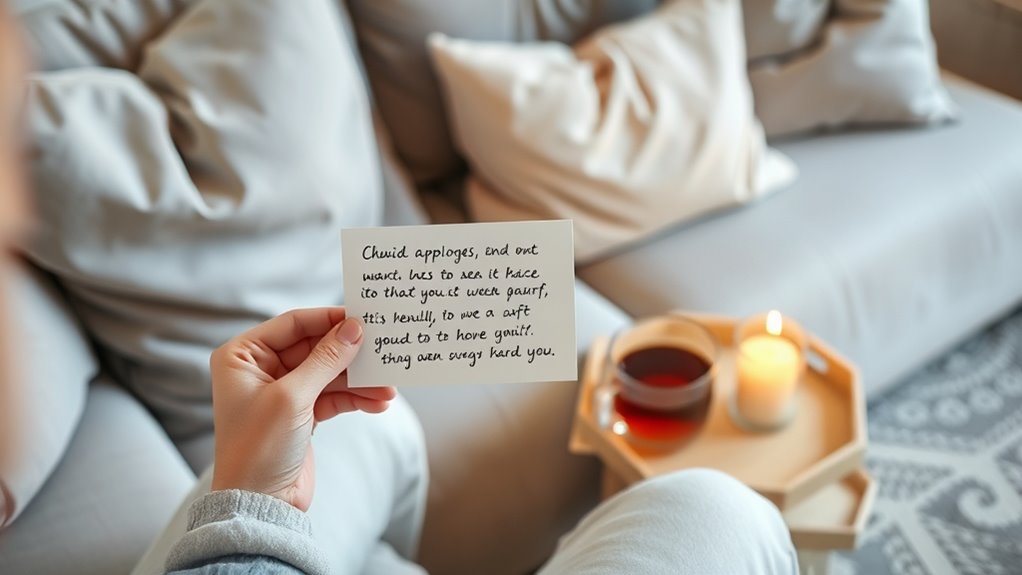When apologizing to someone with BPD, focus on sincere actions and validating their feelings. Use repair rituals like gentle touches or thoughtful messages to reinforce your commitment, and tailor your words to their needs, emphasizing empathy and emotional safety. Be consistent, patient, and accountable to rebuild trust. Recognizing their emotional responses and respecting boundaries creates a foundation for healing. If you want to learn how to create more effective apologies and repair rituals, keep exploring these strategies.
Key Takeaways
- Tailor apology language to the individual’s needs, combining words with actions and emotional validation.
- Use consistent repair rituals like gentle gestures or thoughtful messages to reinforce sincerity.
- Demonstrate accountability through tangible efforts and setting respectful boundaries.
- Prioritize creating emotional safety by actively listening, validating feelings, and fostering trust.
- Practice patience and ongoing effort to rebuild trust, aligning your approach with their emotional landscape.

When misunderstandings or hurtful actions occur, knowing how to apologize effectively can make all the difference in repairing relationships. If you’re steering a relationship where someone has BPD, understanding their apology language and repair rituals becomes even more essential. People with BPD often experience intense emotions and may interpret actions differently, so tailoring your apology to their needs can help rebuild trust and connection.
First, recognize that not everyone responds to apologies in the same way. Some need words to feel heard and understood, while others might require actions to demonstrate genuine remorse. For someone with BPD, emotional validation often holds more weight than simple words. You might find that saying, “I understand why you’re upset,” or “Your feelings are valid,” can soothe their pain more than a generic apology. It’s important to avoid dismissive language or minimizing their feelings, as this can deepen their hurt rather than heal it.
Emotional validation matters most; acknowledge their feelings rather than relying solely on words.
Another key aspect is timing and consistency. People with BPD may have difficulty trusting others, especially after conflicts or perceived betrayals. Your ability to be patient and consistent in your responses shows that you’re committed to making amends. Repair rituals, such as gentle touch if they’re comfortable with it, or sending a thoughtful message later, can reinforce your sincerity. These rituals help create a predictable pattern of reassurance, which can reduce their fears of abandonment or rejection. Additionally, understanding the importance of retail hours and availability can help you plan your interactions more effectively, ensuring your efforts align with their emotional needs.
Additionally, many individuals with BPD respond well to actions that demonstrate accountability. Instead of just saying “I’m sorry,” show that you understand what you did wrong and that you’re actively working to prevent it in the future. This might mean setting boundaries that respect their feelings or making tangible efforts to address underlying issues. These actions communicate that your apology isn’t superficial but rooted in a genuine desire to improve the relationship.
Empathy plays a essential role in these situations. When you genuinely listen and reflect on their perspective, it affirms their experience and helps them feel safe enough to forgive. Remember, for someone with BPD, emotional safety is paramount. Your consistent, validating responses can transform a hurtful incident into an opportunity for growth and deeper understanding.
In short, effective apologies with someone who has BPD involve more than words; they require ongoing effort, patience, and an understanding of their unique emotional landscape. By aligning your apology with their preferred repair rituals and apology language, you foster healing and strengthen your relationship. The goal isn’t just to say sorry but to genuinely reconnect and rebuild trust through consistent, compassionate actions.
Frequently Asked Questions
How Can I Identify My Partner’s Specific Apology Language?
To identify your partner’s apology language, observe how they respond to apologies. Do they value words of affirmation, needing to hear specific remorse? Or do they prefer actions that show you’re sorry, like gestures or changes? Pay attention to what makes them feel truly understood and forgiven. Ask gentle questions and notice their reactions to different apology styles, helping you discover what resonates most with them.
What Are Common Repair Rituals for Bpd-Related Relationship Conflicts?
You can use repair rituals like heartfelt apologies, verbal affirmations, or gestures that show you understand and care. Listening actively and validating your partner’s feelings helps rebuild trust. Creating a routine, such as a comforting hug or a sincere apology followed by a promise to improve, can make a big difference. Consistency and patience are key, showing your partner you’re committed to working through conflicts together.
How Do Apology Languages Differ for Emotional Versus Behavioral Issues?
Did you know that 60% of people prefer different apology styles for emotional versus behavioral issues? You’ll find that emotional apologies focus on validating feelings and showing empathy, while behavioral apologies emphasize taking responsibility and making amends. You might need to tailor your apology language depending on the situation, demonstrating understanding for emotional pain or accountability for actions, to foster trust and healing in your relationship.
Can Apology Languages Change Over Time or With Therapy?
Yes, apology languages can change over time or with therapy. As you grow and work through emotional challenges, you might find your needs and responses evolving. Therapy helps you understand your feelings better, making it easier to communicate what truly matters. With time, you may develop new ways to apologize that feel more authentic and effective, leading to stronger, healthier relationships.
Are There Cultural Differences in Apology Preferences and Repair Rituals?
Yes, cultural differences considerably influence apology preferences and repair rituals. You might find that in some cultures, a formal apology or public acknowledgment is valued, while in others, a more personal, private gesture holds greater importance. Understanding these differences helps you navigate relationships more effectively. By respecting cultural norms, you show genuine care, fostering trust and healing, especially when addressing conflicts or misunderstandings.
Conclusion
Understanding apology languages and repair rituals can truly transform your relationships, especially if you or your partner have BPD. Did you know that 75% of people report feeling more connected after sincere repair efforts? By practicing these strategies, you create a safe space for healing and growth. Remember, small consistent gestures build trust over time. Embrace these tools, and watch your connections strengthen, even during challenging moments.









